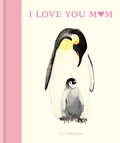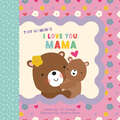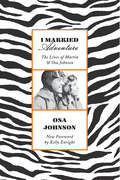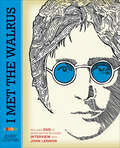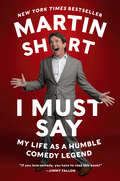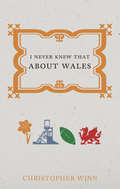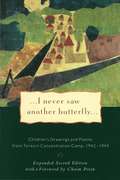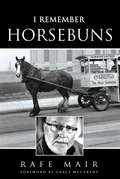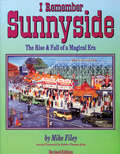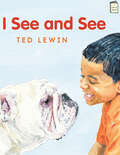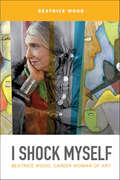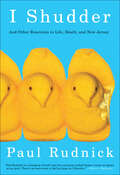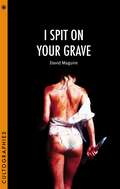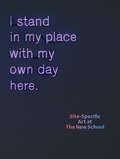- Table View
- List View
I Love You Mum
by Abbie HeadonA mother's hug lasts for long after she lets go. There's nowhere warmer or safer than the embrace of a loving mother, and even as we grow older, our thoughts return again and again to the love we received as infants.Just like us, mums from the natural world are devoted to their little ones. From the cuddly walrus who snuggles her cubs tight in her flippers to the brave tiger who defends her precious young from all possible dangers, celebrate the wonder of mum with this little book that reminds us just how special she is.
I Love You, Mama (Tiny Moments)
by J. D. ForesterThis beautiful board book is the perfect gift for Mother&’s Day.Capturing tender moments between a mother and child, this story celebrates all the care and warmth mothers provide. Moms will love receiving this touching read-aloud.Commemorate some of life&’s biggest milestones and occasions with the Tiny Moments series!
I Loved You in Another Life
by David ArnoldNew York Times bestseller David Arnold returns with a poignant love story about two teens whose souls come together time and again through the ages—for fans of Nina LaCour and Matt Haig.Evan Taft has plans. Take a gap year in Alaska, make sure his little brother and single mother are taken care of, and continue therapy to process his father's departure. But after his mom&’s unexpected diagnosis, as Evan&’s plans begin to fade, he hears something: a song no one else can hear, the voice of a mysterious singer . . .Shosh Bell has dreams. A high school theater legend, she&’s headed to performing arts college in LA, a star on the rise. But when a drunk driver takes her sister&’s life, that star fades to black. All that remains is a void—and a soft voice singing in her ear . . .Over it all, transcending time and space, a celestial bird brings strangers together: from an escaped murderer in 19th century Paris, to a Norwegian kosmonaut in low-earth orbit, something is happening that began long ago, and will long outlast Evan and Shosh. With lyrical prose and original songs (written and recorded by the author), I LOVED YOU IN ANOTHER LIFE explores the history of love, and how some souls are meant for each other—yesterday, today, forever.
I Married Adventure: The Lives of Martin and Osa Johnson (Kodansha Globe Ser.)
by Osa JohnsonA CLASSIC MEMOIR OF TWO PIONEERING ADVENTURERSBefore Joy Adamson went to Africa, before Margaret Mead sailed to Samoa, before Dian Fossey was even born, a Kansas teenager named Osa Leighty married Martin Johnson, a pioneering photographer just back from a ‘round-the-world cruise with Jack London. Together the Johnsons flew and sailed to Borneo, to Kenya, and to the Congo, filming Simba and other popular nature movies with Martin behind the camera and Osa holding her rifle at the ready in case the scene’s big game star should turn hostile. This bestselling memoir retraces their careers in rich detail, with precisely observed descriptions and often heart-stopping anecdotes. Illustrated with scores of the dramatic photos that made the Johnsons famous, it’s a book sure to delight every lover of true adventure.
I Met the Walrus: How One Day With John Lennon Changed My Life Forever
by Jerry LevitanImagine you're the world's biggest Beatles fan and you've just snuck into John Lennon's hotel room. But instead of being thrown out, inexplicably you're invited to spend the day with your idol. That's exactly what happened to fourteen-year-old Jerry Levitan in 1969. After hearing John was in Toronto for a "bed in," Jerry tracked him down at the King Edward Hotel and convinced the world's biggest rock star to sit down for an exclusive forty-minute interview. John talked candidly about war, politics, the scandalous Two Virgins album, and the supposed subliminal messages in his music. Now, forty years later, it's all here: Jerry's once-in-a-lifetime adventure, illustrated by acclaimed artist James Braithwaite and featuring never before seen photographs of John and Yoko. Also included in the book is Jerry's memorabilia from that day—notes from John and Yoko, the secret code to contact him, drawings, John's doodles, and much more. Complete with an audio and video DVD of the interview that inspired the Academy Award-nominated film of the same name, I Met the Walrus is an immortalized one-on-one moment with John—a must-have for Lennon fans around the world, as well as anyone who has ever dreamed of meeting a hero.
I Modify IKEA: Furnishings from Everyone's Favorite Store, Customized for Your Home
by Charlotte Rivers Elyse MajorCUSTOMIZE YOUR FAVORITE IKEA® HOME FURNISHINGS WITH DIY PROJECTS You love IKEA® for its affordable, high-quality home furnishings. Now thanks to this book&’s DIY decorating projects, you can easily transform those furnishings into fully customized decor. Packed with 200 step-by-step illustrations and instructions, I Modify IKEA® offers a range of inspiring ideas to reflect your unique style. Living room: appliqué pillows Dining room: a rolling bar cart Kitchen: embroidered dish towels Bedroom: decorated nightstands Closet: an adorable jewelry box Bathroom: unique shelving Kid's room: a box set dollhouse Office: a cozy reading bench.
I Must Say
by Martin ShortIn this engagingly witty, wise, and heartfelt memoir, Martin Short tells the tale of how a showbiz obsessed kid from Canada transformed himself into one of Hollywood's favorite funnymen, known to his famous peers as the "comedian's comedian."Short takes the reader on a rich, hilarious, and occasionally heartbreaking ride through his life and times, from his early years in Toronto as a member of the fabled improvisational troupe Second City to the all-American comic big time of Saturday Night Live, and from memorable roles in such movies as ¡Three Amigos! and Father of the Bride to Broadway stardom in Fame Becomes Me and the Tony-winning Little Me.He reveals how he created his most indelible comedic characters, among them the manic man-child Ed Grimley, the slimy corporate lawyer Nathan Thurm, and the bizarrely insensitive interviewer Jiminy Glick. Throughout, Short freely shares the spotlight with friends, colleagues, and collaborators, among them Steve Martin, Tom Hanks, Gilda Radner, Mel Brooks, Nora Ephron, Eugene Levy, Catherine O'Hara, Paul Shaffer, and David Letterman.But there is another side to Short's life that he has long kept private. He lost his eldest brother and both parents by the time he turned twenty, and, more recently, he lost his wife of thirty years to cancer. In I Must Say, Short talks for the first time about the pain that these losses inflicted and the upbeat life philosophy that has kept him resilient and carried him through.In the grand tradition of comedy legends, Martin Short offers a show-business memoir densely populated with boldface names and rife with retellable tales: a hugely entertaining yet surprisingly moving self-portrait that will keep you laughing--and crying--from the first page to the last.
I Must Say
by Martin ShortIn this engagingly witty, wise, and heartfelt memoir, Martin Short tells the tale of how a showbiz obsessed kid from Canada transformed himself into one of Hollywood's favorite funnymen, known to his famous peers as the "comedian's comedian."Short takes the reader on a rich, hilarious, and occasionally heartbreaking ride through his life and times, from his early years in Toronto as a member of the fabled improvisational troupe Second City to the all-American comic big time of Saturday Night Live, and from memorable roles in such movies as ¡Three Amigos! and Father of the Bride to Broadway stardom in Fame Becomes Me and the Tony-winning Little Me.He reveals how he created his most indelible comedic characters, among them the manic man-child Ed Grimley, the slimy corporate lawyer Nathan Thurm, and the bizarrely insensitive interviewer Jiminy Glick. Throughout, Short freely shares the spotlight with friends, colleagues, and collaborators, among them Steve Martin, Tom Hanks, Gilda Radner, Mel Brooks, Nora Ephron, Eugene Levy, Catherine O'Hara, Paul Shaffer, and David Letterman.But there is another side to Short's life that he has long kept private. He lost his eldest brother and both parents by the time he turned twenty, and, more recently, he lost his wife of thirty years to cancer. In I Must Say, Short talks for the first time about the pain that these losses inflicted and the upbeat life philosophy that has kept him resilient and carried him through.In the grand tradition of comedy legends, Martin Short offers a show-business memoir densely populated with boldface names and rife with retellable tales: a hugely entertaining yet surprisingly moving self-portrait that will keep you laughing--and crying--from the first page to the last.
I Must Say
by Martin ShortIn this engagingly witty, wise, and heartfelt memoir, Martin Short tells the tale of how a showbiz obsessed kid from Canada transformed himself into one of Hollywood's favorite funnymen, known to his famous peers as the "comedian's comedian."Short takes the reader on a rich, hilarious, and occasionally heartbreaking ride through his life and times, from his early years in Toronto as a member of the fabled improvisational troupe Second City to the all-American comic big time of Saturday Night Live, and from memorable roles in such movies as ¡Three Amigos! and Father of the Bride to Broadway stardom in Fame Becomes Me and the Tony-winning Little Me.He reveals how he created his most indelible comedic characters, among them the manic man-child Ed Grimley, the slimy corporate lawyer Nathan Thurm, and the bizarrely insensitive interviewer Jiminy Glick. Throughout, Short freely shares the spotlight with friends, colleagues, and collaborators, among them Steve Martin, Tom Hanks, Gilda Radner, Mel Brooks, Nora Ephron, Eugene Levy, Catherine O'Hara, Paul Shaffer, and David Letterman.But there is another side to Short's life that he has long kept private. He lost his eldest brother and both parents by the time he turned twenty, and, more recently, he lost his wife of thirty years to cancer. In I Must Say, Short talks for the first time about the pain that these losses inflicted and the upbeat life philosophy that has kept him resilient and carried him through.In the grand tradition of comedy legends, Martin Short offers a show-business memoir densely populated with boldface names and rife with retellable tales: a hugely entertaining yet surprisingly moving self-portrait that will keep you laughing--and crying--from the first page to the last.
I Must Say: My Life As a Humble Comedy Legend
by Martin ShortIn this engagingly witty, wise, and heartfelt memoir, Martin Short tells the tale of how a showbiz- obsessed kid from Canada transformed himself into one of Hollywood's favorite funnymen, known to his famous peers as the "comedian's comedian."Short takes the reader on a rich, hilarious, and occasionally heartbreaking ride through his life and times, from his early years in Toronto as a member of the fabled improvisational troupe Second City to the all-American comic big time of Saturday Night Live, and from memorable roles in such movies as ¡Three Amigos! and Father of the Bride to Broadway stardom in Fame Becomes Me and the Tony-winning Little Me.He reveals how he created his most indelible comedic characters, among them the manic man-child Ed Grimley, the slimy corporate lawyer Nathan Thurm, and the bizarrely insensitive interviewer Jiminy Glick. Throughout, Short freely shares the spotlight with friends, colleagues, and collaborators, among them Steve Martin, Tom Hanks, Gilda Radner, Mel Brooks, Nora Ephron, Eugene Levy, Catherine O'Hara, Paul Shaffer, and David Letterman.But there is another side to Short's life that he has long kept private. He lost his eldest brother and both parents by the time he turned twenty, and, more recently, he lost his wife of thirty years to cancer. In I Must Say, Short talks for the first time about the pain that these losses inflicted and the upbeat life philosophy that has kept him resilient and carried him through.In the grand tradition of comedy legends, Martin Short offers a show-business memoir densely populated with boldface names and rife with retellable tales: a hugely entertaining yet surprisingly moving self-portrait that will keep you laughing--and crying--from the first page to the last.
I Never Knew That About Wales
by Christopher WinnThe inspiration for the primetime ITV series on Great Britain, this is a spellbinding journey around Wales by bestselling author Christopher Winn. Packed full of legends, firsts, birthplaces, inventions and adventures, I Never Knew That About Wales visits the thirteen traditional Welsh counties and unearths the hidden gems that they each hold. Discover where history and legends happened; where people, ideas and inventions began; where dreams took flight; where famous figures were born and now rest. A glittering pantheon of writers and artists, thinkers and inventors, heroes and villains have lived and toiled in this small country. Remarkable events, noble (and dastardly) deeds and exciting adventures have all taken place with Wales as their backdrop. This book seeks out their heritage, their monuments, their memories and their secrets. You'll be able to visit Britain's smallest city, St David's with its glorious 12th-century cathedral slumbering in a sleepy hollow near the sea. Explore Britain's greatest collection of castles from the first stone fortress at Chepstow to Britain's finest concentric castle at Beaumaris and the magnificent Caernarvon, birthplace of the first Prince of Wales. Browse through the second hand book capital of the world, Hay-on-Wye, wander the glorious Gower peninsula, Britain's first Area of Outstanding Natural Beauty. Take a trip to Fishguard, where the last invasion of Britain took place in 1797. Marvel at Thomas Telford's Menai Bridge, the world's first iron suspension bridge or Pontcysyllte, the longest bridged aqueduct in Britain. This irresistible compendium of interesting facts and good stories will give you a captivating insight into the people, ideas and events that have shaped the individual identity of every place you visit, and will have you exclaiming again and again: 'Well, I never knew that!'
I Never Knew What Time It Was
by David AntinAntin explores the experience of time--how it's felt, remembered, and recounted. These free-form talk pieces--sometimes called talk poems or simply talks--began as improvisations at museums, universities, and poetry centers where Antin was invited to come and think out loud.
I Never Saw Another Butterfly
by Hana VolavkovaFifteen thousand children under the age of fifteen passed through the Terezin Concentration Camp. Fewer than 100 survived. In these poems and pictures drawn by the young inmates, we see the daily misery of these uprooted children, as well as their hopes and fears, their courage and optimism. 60 color illustrations.
I Paint What I Want to See (Penguin Modern Classics)
by Philip GustonIlluminating reflections on painting and drawing from one of the most revered artists of the twentieth century'Thank God for yellow ochre, cadmium red medium, and permanent green light'How does a painter see the world? Philip Guston, one of the most influential artists of the twentieth century, spoke about art with unparalleled candour and commitment. Touching on work from across his career as well as that of his fellow artists and Renaissance heroes, this selection of his writings, talks and interviews draws together some of his most incisive reflections on iconography and abstraction, metaphysics and mysticism, and, above all, the nature of painting and drawing.'Among the most important, powerful and influential American painters of the last 100 years ... he's an art world hero' Jerry Saltz, New York Magazine'Guston's paintings make us think hard' Aindrea Emelife, Guardian
I Remember Horsebuns
by Rafe MairKnown to most as a polarizing figure in Canadian and British Columbian politics, and an outspoken voice in print and radio, Rafe Mair shares with his readers the side to him that is entirely human, relatable, and even loving in his latest memoir, I Remember Horse Buns. Above all, Rafe shares his love affair with Vancouver, British Columbia. Starting his tale in 1931, Rafe tells of exciting areas for kids to explore with minimal interference from parents. It was a time when there were actually streams you could fish in. It was the time of comic books, radio shows, and Saturday afternoon at the movies. Rafe relates the early days when he was forming thoughts on issues like the environment, free speech, and the press. He remembers the McCarthy era that started in Ottawa when a Soviet cipher clerk defected and Russia was no longer our Great Ally. He describes his love of books and writing, and he exposes Trotsky--Trotsky the bear, that is! Join Canadian best-selling author, recovering politician and renowned talk show host Rafe Mair as he remembers Vancouver, British Columbia, and Canada... and horse buns.
I Remember Sunnyside
by Mike FileyFirst published in 1982, I Remember Sunnyside is a mine of golden memories, bringing back to life an earlier Toronto, only hints of which remain today.Like the city itself, Sunnyside was an everchanging landscape from its heady opening days in the early 1920s to its final sad demolition in the 1950s. The book captures the spirit of the best of times a magical era which can only be recaptured in memory and photographs. It also presents the reality of a newer Toronto where change, although necessary, is sometimes regrettable.
I Said Yes: My Story of Heartbreak, Redemption, and True Love
by Emily Maynard JohnsonNEW YORK TIMES BESTSELLERMillions know Emily Maynard Johnson from her appearances on both The Bachelor and The Bachelorette. At the end of a long, fruitless search for a husband, Emily found that waiting right in front of her all along was the truest love of all: the unconditional love of the Lord. Overcome with embarrassment following her nationally televised heartbreaks, Emily finally committed herself to the only one she knew would never leave her empty and alone. Abandoning her need to be chosen by men and finding peace in the fact that she was already chosen by God, Emily found the joy she had been looking for in serving God.I Said Yes chronicles Emily's experiences on both The Bachelor and The Bachelorette and the way that God turned her life upside down through the knowledge and acceptance of His true love.As Emily sheds light on her life as a believer in the spotlight, she teaches us:How to embrace the gift of true redemptionWhat it means to fully surrender your heart to GodHow to say yes to God's ways, God's love, and God's timing In I Said Yes, Emily tells the story of her life before and after reality TV fame, describing the profound new reality she discovered when she traded fame in favor of the Lord--and to that unconditional love, Emily said yes.
I See and See (I Like to Read)
by Ted LewinAn observant boy sees many things on his way home from school. A dog, a truck, a bird, a butterfly. . . these ordinary urban experiences become artistic inspiration for the boy. When he gets home, he draws all of the things he saw. Now he can see them at home, too! Caldecott Honor medalist Ted Lewin’s magnificent, lifelike paintings transform the boy’s everyday walk into an enchanting exploration of his surroundings. Emerging readers will like the simple, repetitive text, and will challenge themselves to see what the boy sees—and more. An I Like to Read® book. Guided Reading Level B.
I Shock Myself: Beatrice Wood, Career Woman of Art
by Beatrice WoodIn her own charming, spirited, and readable style, Beatrice Wood tells us the story of her unorthodox life and her influence on 20th-century art. Rebellious, radical, and romantic, Wood (1893–1998) defied propriety to become a true national, and international, treasure. Her absorbing autobiography includes vintage documents and her own personal photos and sketches of her many famous friends and acquaintances in the art world. She became romantically involved with the Dadaist Marcel Duchamp, and offers rare glimpses into the lives of her circle, including key cultural figures like Constantin Brancusi, Isadora Duncan, Edna St. Vincent Millay, Anais Nin, and Krishnamurti. At age forty Wood studied ceramics and went on to become one of the major ceramists of the 20th century, working until her death at age 105. This captivating chance to enjoy Wood's rare charisma and spirit provides a better understanding of American art and the people who have shaped it.
I Shudder: And Other Reactions to Life, Death, and New Jersey
by Paul RudnickComic essays from the author of Farrell Covington and the Limits of Style: &“There&’s no book wiser or half as funny as I Shudder.&” —David Sedaris I Shudder is a side-splittingly funny collection of essays from Paul Rudnick, one of America&’s preeminent humorists—a playwright, screenwriter, novelist, and regular contributor to the New Yorker. The reviews say it all: &“A hilarious, often touching hodgepodge of essays about his work and his life with his pleasingly demented family.&” —People (4 stars) &“Uproariously self-deprecating essays about being gay and Jewish in suburban New Jersey and downtown Manhattan.&” —The New York Times Book Review &“A likable and accomplished raconteur who never loses sight of his own absurdity.&” —The Washington Post &“Smart, dishy, and very funny.&” —Daily News &“An acerbic and entertaining memoir.&” —Entertainment Weekly &“I Shudder is filled with deeply funny musings and adventures that elevate Paul Rudnick to the highest level of American comedy writing. It should be noted that I would be at the highest level of American comedy writing if I had had Paul&’s early advantages.&” —Steve Martin
I Sold Andy Warhol (Too Soon)
by Richard PolskyIn early 2005, Richard Polsky decided to put his much-loved, hard-won Warhol Fright Wig, up for auction at Christie's. The market for contemporary art was robust and he was hoping to turn a profit. His instinct seemed to be on target: his picture sold for $375,000. But if only Polsky had waited . . . Over the next two years, prices soared to unimaginable heights with multimillion-dollar deals that became the norm and not the exception. Buyers and sellers were baffled, art dealers were bypassed for auction houses, and benchmark prices proved that trees really do grow to the sky. Had the market lost all reason?In I Sold Andy Warhol (Too Soon), Polsky leads the way through this explosive, short-lived period when the "art world" became the "art market." He delves into the behind-the-scenes politics of auctions, the shift in power away from galleries, and the search for affordable art in a rich man's playing field. Unlike most in the art world, Polsky is not afraid to tell it like it is as he negotiates deals for clients in New York, London, and San Francisco and seeks out a replacement for his lost Fright Wig in a market that has galloped beyond his means. A compelling backdoor tell-all about the strange and fickle world of art collecting, I Sold Andy Warhol (Too Soon) takes an unvarnished look at how the industry shifted from art appreciation to monetary appreciation.From the Hardcover edition.
I Spit on Your Grave (Cultographies)
by David MaguireThere is no denying that Meir Zarchi’s I Spit on Your Grave (1978) deserves its title as one of the most controversial films ever made. While many condemn it as misogynistic, others praise it for raising uncomfortable issues about sexual violence. While its reputation as a cult film has undoubtedly been cemented by its unique position in the 1970s/80s exploitation era and the "video nasties" scandal, it has also become mythologized by its own official and unofficial franchises.David Maguire examines why the film still continues to provoke fierce debate forty years on, not only investigating the historical, social, and political landscape into which the film was first released—and condemned—but also examining how it is has inadvertently become ground zero for the rape-revenge genre because of its countless imitators. The book explores how academic study has reevaluated the film’s importance as a cultural statement on gender, the conflicting readings that it throws up, the timeless appeal of its story as examined through folklore and mythology, and its updating to reflect contemporary issues in a post-9/11 world of vengeance and retaliation.
I Spy DIY Style: Find Fashion You Love and Do It Yourself
by Jenni RadosevichLoved it on the runway? Seen it in a magazine? Find fashion you love and do it yourself! With a few simple supplies and a range of clever ideas, DIY expert Jenni Radosevich shows you how to make style your own. Transform your basics into designer fashions. Turn hardware store finds into statement necklaces or embellishments for a chic dress. Recreate red carpet-ready looks and add your personal touch. Filled with 30 step-by-step projects inspired by celebrities, designer runways, and classic styles, as well as tips from fashion insiders such as Rachel Roy, Olivia Palermo, and Rebecca Minkoff, I Spy DIY Style has everything you need for easy-to-make looks that will up your style quotient without sacrificing your budget.
I Spy: Representations of Childhood
by Catherine FehilyAttempting to address the photography of children in the late 1990s is a difficult and potentially dangerous exercise. _I Spy_ takes up the challenge by means of a unique combination of new colour and black and white photographs and newly commissioned writing. A book to savour, it addresses two related issues in the contemporary photography of children: how children photograph themselves and how they are portrayed by modern women photographers. It includes, for example, children's photographs of their homes, families and environment, a body of work on twins, a mother's photographs of her daughter and powerful essays expressing poetic, personal and critical approaches. Together, images and words describe intimate, surprising facets of the visual world of childhood.The contributors are: Melissa Benn, Linda Bullock, Wendy Ewald, Catherine Fahily, Jane Fletcher, Suzanne Greenslade, Patricia Holland, Holly Street Public Art Trust, Caroline Molloy, Kate Newton, Cath Pearson
I Stand in My Place With My Own Day Here: Site-Specific Art at The New School
by Frances RichardI Stand in My Place with My Own Day Here features essays by more than fifty renowned international writers who consider thirteen monumental works of art created for The New School between 1930 and the present. The nucleus of The New School's Art Collection, these commissions—ranking among the finest site-specific works in New York City—range from murals by José Clemente Orozco and Thomas Hart Benton to installations by Agnes Denes, Kara Walker, Alfredo Jaar, Glenn Ligon, Sol LeWitt, and Martin Puryear + Michael Van Valkenburgh, among others. Providing a kaleidoscopic view into these works, this richly illustrated volume explores each installation through three to four essays written by critics, poets, and scholars from diverse fields including anthropology, mathematics, art history, media studies, and design. Their texts are complemented by three additional essays reflecting on each piece's art historical significance; the architectural contexts in which the works reside on the university's campus; and The New School's relationship to adventurous art practice. Also included is a roundtable discussion among leading arts educators and artists who reflect on the pedagogical potential of a campus-based contemporary art collection. The book's final section presents a history of each commissioned work, highlighted by archival images never before published. Published by The New School. Distributed by Duke University Press. Contributors. Saul Anton, Daniel A. Barber, Stefano Basilico, Carol Becker, Naomi Beckwith, Omar Berrada, Gregg Bordowitz, Tisa Bryant, Holland Cotter, Mónica de la Torre, Aruna D'Souza, Elizabeth Ellsworth, Julia L. Foulkes, Andrea Geyer, Kathleen Goncharov, Jennifer A. González, Michele Greet, Randall Griffey, Victoria Hattam, Pablo Helguera, Jamer Hunt, Anna Indych-López, Luis Jaramillo, Jeffrey Kastner, Robert Kirkbride, Lynda Klich, Carin Kuoni, Sarah E. Lawrence, Tan Lin, Lucy R. Lippard, Laura Y. Liu, Reinhold Martin, Shannon Mattern, Lydia Matthews, Maggie Nelson, Olu Oguibe, G. E. Patterson, Hugh Raffles, Claudia Rankine, Jasmine Rault, Heather Reyes, Frances Richard, Silvia Rocciolo, Carl Hancock Rux, Luc Sante, Mira Schor, Eric Stark, Radhika Subramaniam, Edward J. Sullivan, Roberto Tejada, Otto von Busch, Wendy S. Walters, Jennifer Wilson, Mabel O. Wilson
